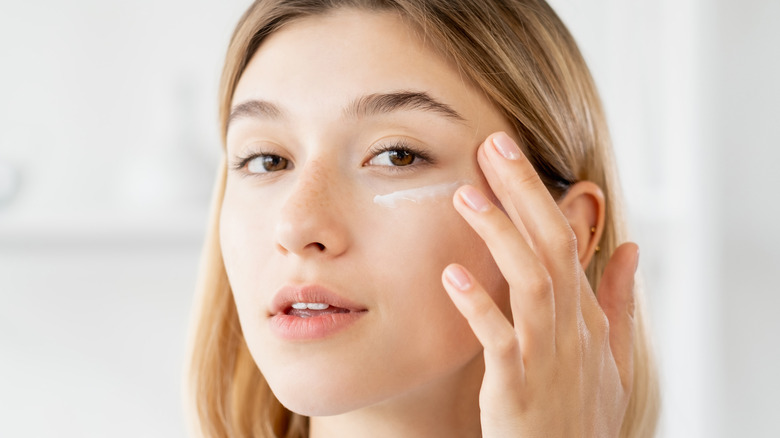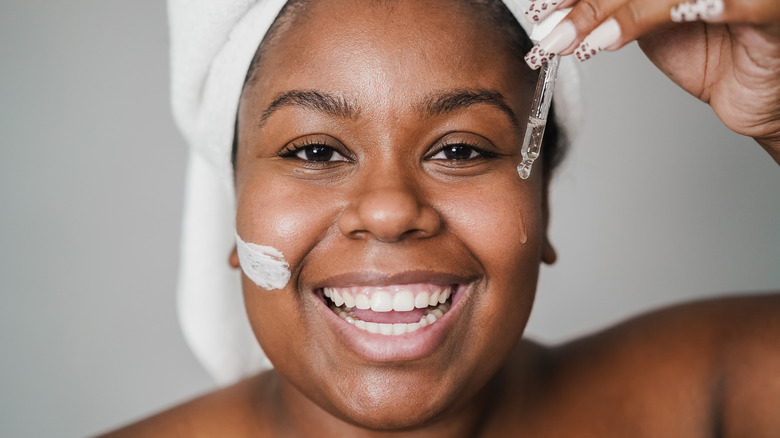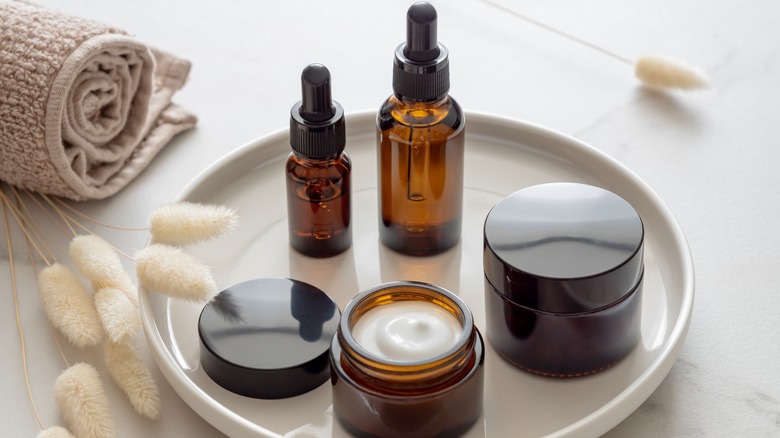How Are Retinol And Retinal Different?
We may receive a commission on purchases made from links.
Retinoids were first used by dermatologist Dr. Albert M Kligman to treat acne in 1971 (via Derma Store), but it took a few decades before the miracle skincare ingredient resurfaced into mainstream over-the-counter products. "Retinoids and retinols change how a cell functions, specifically the speed at which a cell turns over, or divides, to create new cells," dermatologist Zakia Rahman, MD told Stanford Medicine. "[Retinoids] thicken the epidermis through increased cell proliferation at the top level. They increase the production of natural chemicals (such as hyaluronic acid) in your skin that keep it plump and moist. They stimulate collagen production and inhibit the breakdown of collagen that already exists. They also block several inflammatory pathways that exacerbate pimples and acne," she said.
Now, retinoids are omnipresent. In fact, retinol was a top searched skincare ingredient in 2020 (via Byrdie) and they are included in almost every "anti-aging" formulation. Considering the staggering list of benefits on its resume, retinoid was bound to become popular in a society obsessed with clear, perfect skin. But before you rush to grab your nearest retinoid (trust us, you won't have to look far), make sure you're grabbing the right one.
Retinol and retinal are forms of retinoid
Retinoids are a class of vitamin A derivatives that can be found in OTC products as well as prescription-based products. The term retinol has become synonymous with retinoids but there are many forms of retinoids that you can choose from, depending on your skin type and concern. One of the main aspects that these forms of retinoids differ in is their strength and the speed at which they work. This comes down to how long they take to become retinoic acid — aka the active that actually works on your skin. Tretinoin and Tazarotene are some of the more potent (prescription only) retinoids that don't need to convert since they're actives already (via Caroline Hirons). However, retinol is a ingredient that requires a two-step oxidation process to convert into retinoic acid, which reduces its efficacy and makes it gentle on your skin (via National Library of Medicine). This is also why its used in most OTC products.
However, if you're looking for a slightly stronger alternative that doesn't require a visit to the doctor's office, retinal might be your best bet. Unlike retinol, which requires two steps to become retinoic acid, retinal or retinaldehyde only needs one. This means it takes less time to work on your skin, making it a more effective option than retinol. However, skin irritation is more likely with this retinoid derivative.
Retinal is stronger than retinol
The benefits of using both retinol and retinaldehyde are similar; they both increase cell turnover and reduce the appearance of wrinkles, fine lines, and photo-aging. However, this process can lead to minor irritation and dryness that is often associated with retinoids (via Healthline). If you have sensitive skin, you may want to start with one of the best retinol serums or a product with a low percentage of retinol (but always patch test it first). However, if your skin has become accustomed to retinol, it may be ready for a dose of retinal.
Retinaldehyde can also be found over-the-counter (the Avène Retinal is a crowd favorite), and it could be the closest to prescription-strength without a prescription. A study published in the Journal of the American Academy of Dermatology compared 0.05% retinaldehyde and 0.05% retinoic acid to find that the results and efficacy were very similar. The only difference was that retinal did not irritate participants as much as retinoic acid. We're only seeing pros with retinals so far, but you should consult a dermatologist before adding them to your routine. Of course, you can also consult our guide on what not to mix with retinol until then.


